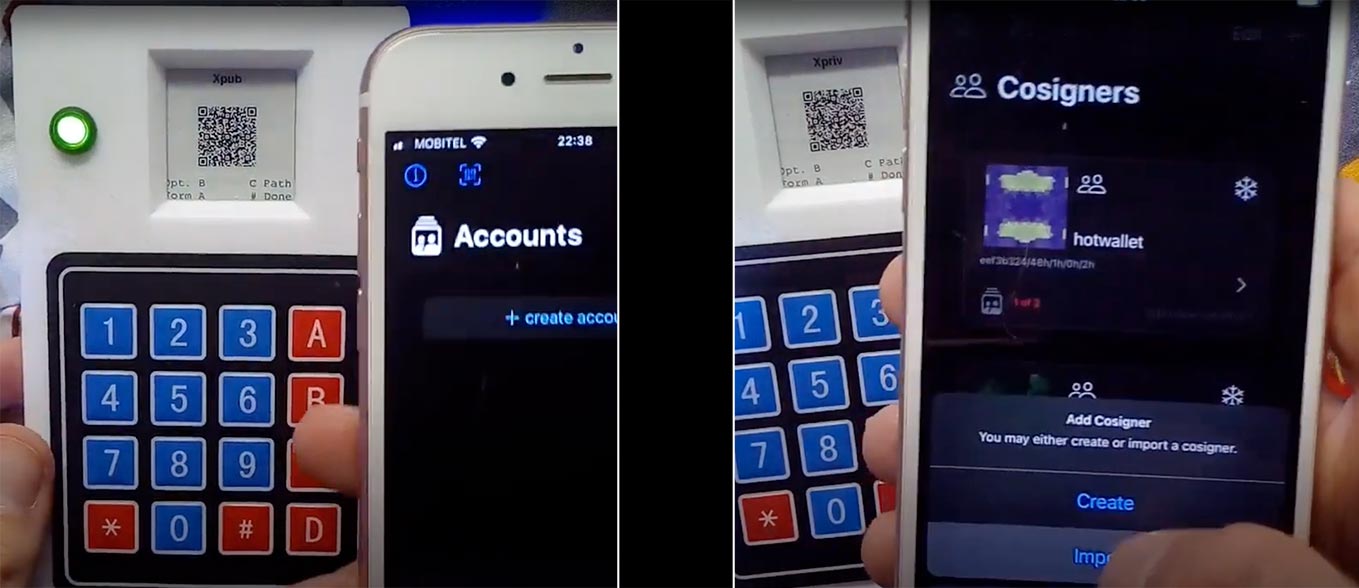Uniform Resources (URs) allow for the encoding of self-describing, structured binary data in text strings that can are optimized for transmission in QR Codes including animated QRs. We now suggest storing this data as Gordian Envelopes before encoding as a UR, but we have specified the storage of a variety of sorts of “bare” data in our Registry of UR Types, including a variety of key material such as seeds, keys, and SSKR shares, and there still may be a use case for doing so rather than creating a more extensive Envelope.
Key material is the most valuable data in a cryptography system because private keys and the seeds from which they are derived control cryptocurrency, verify identity, and serve other crucial purposes. For this reason it should be carefully secured — if possible with airgapping, where the material is held in some non-networked place. That’s where URs (or UR Envelopes) come in. They allow key material to be encoded as URs, converted into QRs, and then transmitted across an airgap in a way that’s safe and secure, minimizing its vulnerability at the time when it’s the most vulnerable.

The above image, drawn from an interoperability demo for LetheKit and
Gordian Cosigner shows
how an xpub and an xprv can be transmitted between airgapped
devices using standardized, typed URs.
The following major categories of key material are available as URs: seeds, HD keys, EC keys, public-key cryptography keys, and other cryptographic keys and signatures. The Envelopes taht could alternatively be used to encode all of this are described in an IETF draft.
Why Use URs for Key Material?
Why use URs for your key material when you could pass bare seeds, the
mnemonic words themselves, or xprvs and xpubs for HD keys?
The biggest reason is interoperability. URs are all self-identifying, so you always know exactly what you’re getting. They’re also built to be encoded into QRs, which is a great way to transfer data across airgaps. The result is an easy, safe way to transfer key material and to expect that it will be understood by products produced by a variety of other manufacturers.
This is particularly important for key material because, as noted earlier, it is both the core of controlling cryptocurrency (and other digital assets) and uniquely vulnerable to theft or loss.
- By using a system that integrates well with airgaps, you can maximize the safety of key material without potentially falling prey to man-in-the-middle attacks and you can simultaneously maintain the security of airgapped devices.
- By using a self-describing, interoperable method to store key material, you can ensure that it will remain well-understood and thus usable far into the future, not becoming muddled with the huge variety of standards for key material that could otherwise result in it becoming effectively unsuable if a user has no idea what it is.
Note that URs can only hold bare content, while Envelopes can hold multiple bits of data as well as metadata about the contents of an Envelope. This multiplies the self-descriptive properties of URs while also building on URs’ other advantages.
Key Material: seed
A seed is the basis of a cryptocurrency or identity account. It’s typically generated by a wallet, or alternatively a seed generator such as Blockchain Commons’ LetheKit or seedtool.
A Simple Seed
The example uses Blockchain Commons’ default 128-bit seed, YINMN BLUE.

HEX: 59f2293a5bce7d4de59e71b4207ac5d2
BIP-39 WORDS: fly mule excess resource treat plunge nose soda reflect adult ramp planet
BYTEWORDS: hawk whiz diet fact help taco kiwi gift view noon jugs quiz crux kiln silk tied omit keno lung jade
GORDIAN ENVELOPE (with METADATA): ur:envelope/lptpsogdhkwzdtfthptokigtvwnnjsqzcxknsktdoybdtpsojyhkinjtjnjtcxfwjzkpihcxfpiainiecxfekshsjnoyadcsspoybetpsosecyidbbwnnnoyaatpsoksdighisinjkcxinjkcxjlkpjpcxjkjyhsjtiehsjpiecxeheyetdpidinjycxjyihjkjycxjkihihiedmplrnihld
SEGWIT UR OUTPUT DESCRIPTOR: ur:output-descriptor/oeadisktjojeisdefzdydtaolytantjloxaxhdclaxvlcprfttldjobkredtlnhsidwybaeyjtswyandlgjnehtkdsidbkqzsrkphyfhsaaahdcxhnfgnepefxgdytryckticelyotsstoknfntavevaskiddmolsarntykbrybtjpksamtantjooeadlncsghykaeykaeykaocyhngrmuwzaycyzssajpsndifmkohy
SEGWIT TEXT OUTPUT DESCRIPTOR: wpkh([604b93f2/84'/0'/0']xpub6DVfq9VduocgjGeR69Nyr8CCi9w5gywnU7wXMYGswpHjffjcbLYNzz6G6555VDcSZLDwZPzJHJQabVWWgkpvYntpunL3UjHGrkCJ6VndbQf)#ncwysjuk
![]() Do not use this seed to hold real monies; they could
disappear immediately!
Do not use this seed to hold real monies; they could
disappear immediately!
A simple, unadorned seed looks like this:
59F2293A5BCE7D4DE59E71B4207AC5D2
As discussed in the UR Overview, this seed can be converted to the CBOR A1015059F2293A5BCE7D4DE59E71B4207AC5D2 and then a ur:seed:
ur:seed/oyadgdhkwzdtfthptokigtvwnnjsqzcxknsktdhpyljeda
Decoding a Simple Seed
The Bytewords and CBOR apps demonstrate how this seed can then be broken down into its constituent parts.
The bytewords CLI can be used to convert the Bytewords minimal encoding used in URs to CBOR:
$ bytewords -i minimal -o hex OYADGDHKWZDTFTHPTOKIGTVWNNJSQZCXKNSKTDHPYLJEDA
a1015059f2293a5bce7d4de59e71b4207ac5d2
The CBOR CLI can then be used to decode the result, revealing a map with just one item, which is the seed itself:
$ cbor2diag -x a1015059f2293a5bce7d4de59e71b4207ac5d2
{1: h'59f2293a5bce7d4de59e71b4207ac5d2'}
UR was built to support clean and efficient conversion into QR codes. That same seed can be encoded into a QR code as following:

If you read this with a QR reader you’ll get:
UR:SEED/OYADGDHKWZDTFTHPTOKIGTVWNNJSQZCXKNSKTDHPYLJEDA
A Seed with Metadata
More complex examples of ur:seed may incorporate a creation
date (map element #2, tagged 100), a name (map element #3), and/or a
note (map element #4) as detailed in the seed
CDDL.
The CBOR for a ur:seed containing all of these elements could look like the following:
a4015059f2293a5bce7d4de59e71b4207ac5d202D8641A6092DC07036541636F726E046C436F66666565206D6F6E6579
This is a CBOR map containing four elements.
It breaks apart as shown:
A4 # map(4)
01 # element #1
50 # 16 bytes in length
59F2293A5BCE7D4DE59E71B4207AC5D2 # SEED
02 # element #2
D8 64 # tag(100) (date)
1A 6092DC07 # CREATION DATE (1620237319)
03 # element #3
65 # 5-character text
41636F726E # NAME ("Acorn")
04 # element #4
6C # 12-character text
436F66666565206D6F6E6579 # NOTE("Coffee money")
The cbor2diag CLI can similarly be used to decode this information:
$ cbor2diag -x a4015059f2293a5bce7d4de59e71b4207ac5d202D8641A6092DC07036541636F726E046C436F66666565206D6F6E6579
{
1: h'59f2293a5bce7d4de59e71b4207ac5d2',
2: 100(1620237319),
3: "Acorn",
4: "Coffee money"
}
Using the Bytewords-cli you can convert the CBOR to minimal Bytewords:
$ bytewords -i hex -o minimal a4015059f2293a5bce7d4de59e71b4207ac5d202D8641A6092DC07036541636F726E046C436F66666565206D6F6E6579
oxadgdhkwzdtfthptokigtvwnnjsqzcxknsktdaotpiecyhnmouoataxihfpiajljpjtaajzfxjliyiyihihcxjnjljtihkkpseernwl
And you have a ur:seed:
UR:SEED/OXADGDHKWZDTFTHPTOKIGTVWNNJSQZCXKNSKTDAOTPIECYHNMOUOATAXIHFPIAJLJPJTAAJZFXJLIYIYIHIHCXJNJLJTIHKKPSEERNWL
A Seed in Envelope
The preferred method for encoding seeds is now to use a Gordian Envelope.
This is that same seed stored in a Gordian Envelope, which of course still uses UR formatting:
ur:envelope/lntpsogdhkwzdtfthptokigtvwnnjsqzcxknsktdoyadcsspoybdtpsokseceheyetdpidinjycxguihihiecxgdkpidjziniacxghihjkjycxhfihiajyjljpcxdehkinjtjnjtcxfwjzkpihdtcxendyeeideseoiyeyoyaatpsokkadwdghisinjkcxinjkcxjyisihcxeheyetdpidinjycxdeeyeecxktjljpiedtcxjkihihiecxkpjkihiecxhsjkcxhscxjokpidjziniacxjpihiojpihjkjkinjljtcxjyihjkjycxkoihiajyjljpcxiyjljpcxgogmjkdwcxfljljpieinhsjtcxguihihiecxghjljljzdwcxhsjtiecxjkihihiejyjljljzdpiajzindmbkbkghisinjkcxjkihihiecxhsjtiecxhsjzjzcxjeihkkjkcxioihjtihjphsjyihiecxiyjpjljncxinjycxjkisjlkpjziecxidihcxiajljtjkinieihjpihiecxkpjtjkihiakpjpihcxhsjkcxjyisinjkcxjeihkkcxjnhsjyihjpinhsjzcxinjkcxidihinjtiocxjkishsjpihiecxjokpidjziniajzkkcxhsjkcxhscxjyihjkjycxkoihiajyjljpdmbkbkfpjzjkjlcxjejtjlktjtcxhsjkcxfygdfpgscxdpcxvolansfyhsjpjecxgdkpjpjojzihcxfpjskphscxgsjlkoihvolantcxhsjkcxhsjtcxjljziecxkoihjpjkinjljtcxjliycxgsiniyihfdhsjkiscxishsiecxjyishsjycxiajljzjljpdmbkbkfwinjyiajlinjtcxgthsjkjyihjpcxgrihkkcxfginjtioihjpjojpinjtjyftcxendyeeideseoiyeybkfejyisihjpihkpjncxfpiaiajlkpjtjycxcndycxfpieiejpihjkjkcxhpjndleeeedidlendyvolanldldyvolanldldydldyhlftcxdyksececemeceyeciedyeeeoeneceniheseoetecfyetfefgfpfpesfxieeehseohsihfpiefedyehehenetbkoycfadzttpsotantjyoeadjsktjkisdeiajljkiniojtihjpdefzdydtdtaolytantjlonaxhdclaohldlmdrtlacxhnfpptplfyltwelafsnezslyndhllnvdimmwlpylkbwzjltbdmenaahdcxlejtimcnrlbtdemdoereyaqzprkpndbdgwfzflqdbzkohgzobycxcnvabaosbglfamtantjooeadlocsdyykaeykaeykaoykaocyhngrmuwzattantjooyadlslraewkadwklawkaycynewncnlboybetpsosezofptpbtlnlyjzkefmjejldeny
You can convert the minimal Bytewords to hex with the bytewords-cli and then view it in cbor.me:
86 # array(6)
D8 C9 # tag(201)
50 # bytes(16)
59F2293A5BCE7D4DE59E71B4207AC5D2 # "Y\xF2):[\xCE}M\xE5\x9Eq\xB4 z\xC5\xD2"
A1 # map(1)
01 # unsigned(1)
18 C8 # unsigned(200)
A1 # map(1)
0B # unsigned(11)
D8 C9 # tag(201)
78 35 # text(53)
3132382D6269742053656564205075626C6963205465737420566563746F72202859696E6D6E20426C756529203630346239336632 # "128-bit Seed Public Test Vector (Yinmn Blue) 604b93f2"
A1 # map(1)
04 # unsigned(4)
D8 C9 # tag(201)
79 01EA # text(490)
5468697320697320746865203132382D6269742028323420776F726429207365656420757365642061732061207075626C69632072656772657373696F6E207465737420766563746F7220666F72205552732C20476F726469616E205365656420546F6F6C2C20616E642073656564746F6F6C2D636C692E0A0A54686973207365656420616E6420616C6C206B6579732067656E6572617465642066726F6D2069742073686F756C6420626520636F6E7369646572656420756E7365637572652061732074686973206B6579206D6174657269616C206973206265696E6720736861726564207075626C69636C792061732061207465737420766563746F722E0A0A416C736F206B6E6F776E206173204450414C202D20E2809C4461726B20507572706C652041717561204C6F7665E2809D20617320616E206F6C642076657273696F6E206F66204C6966654861736820686164207468617420636F6C6F722E0A0A426974636F696E204D6173746572204B65792046696E6765727072696E743A2036303462393366320A457468657265756D204163636F756E742023302041646472657373205B6D2F3434272F3630E280992F30E280992F302F305D3A203078353537353235643034333635366539333835443845464141394364346133616541644530313136380A # "This is the 128-bit (24 word) seed used as a public regression test vector for URs, Gordian Seed Tool, and seedtool-cli.\n\nThis seed and all keys generated from it should be considered unsecure as this key material is being shared publicly as a test vector.\n\nAlso known as DPAL - “Dark Purple Aqua Love” as an old version of LifeHash had that color.\n\nBitcoin Master Key Fingerprint: 604b93f2\nEthereum Account #0 Address [m/44'/60’/0’/0/0]: 0x557525d043656e9385D8EFAA9Cd4a3aeAdE01168\n"
A1 # map(1)
19 01FC # unsigned(508)
D8 C9 # tag(201)
D9 9D74 # tag(40308)
A2 # map(2)
01 # unsigned(1)
71 # text(17)
77736828636F7369676E65722840302929 # "wsh(cosigner(@0))"
02 # unsigned(2)
81 # array(1)
D9 9D6F # tag(40303)
A5 # map(5)
03 # unsigned(3)
58 21 # bytes(33)
025D2F95C080206041A9AE4487ED803D9FFA819B5D86E76A9485F77EF26FD62E36 # "\u0002]/\x95\xC0\x80 `A\xA9\xAED\x87\xED\x80=\x9F\xFA\x81\x9B]\x86\xE7j\x94\x85\xF7~\xF2o\xD6.6"
04 # unsigned(4)
58 20 # bytes(32)
8A6E6A23B70D2895A2B5F8B4B2759B0B4F4047B3157657FB112023E60EA71282 # "\x8Anj#\xB7\r(\x95\xA2\xB5\xF8\xB4\xB2u\x9B\vO@G\xB3\u0015vW\xFB\u0011 #\xE6\u000E\xA7\u0012\x82"
06 # unsigned(6)
D9 9D70 # tag(40304)
A2 # map(2)
01 # unsigned(1)
88 # array(8)
18 30 # unsigned(48)
F5 # primitive(21)
00 # unsigned(0)
F5 # primitive(21)
00 # unsigned(0)
F5 # primitive(21)
02 # unsigned(2)
F5 # primitive(21)
02 # unsigned(2)
1A 604B93F2 # unsigned(1615565810)
07 # unsigned(7)
D9 9D70 # tag(40304)
A1 # map(1)
01 # unsigned(1)
83 # array(3)
84 # array(4)
00 # unsigned(0)
F4 # primitive(20)
01 # unsigned(1)
F4 # primitive(20)
80 # array(0)
F4 # primitive(20)
08 # unsigned(8)
1A 9FF1237F # unsigned(2683380607)
A1 # map(1)
10 # unsigned(16)
D8 C9 # tag(201)
C1 # tag(1)
FB 41D80D86816C7C3E # primitive(4744557078782966846)
Besides the seed, a name, and a long note, this Envelope also contains an output descriptor. It’s everything that you need to actually make use of the seed when you recover it, while a bare seed can’t provide that information.
You can directly compare that CBOR dump to the dump of the ur:seed above, but if you want even a clearer description of your ur:envelope, all you need to do is examine it in bc-envelope-cli-rust:
$ envelope format ur:envelope/lntpsogdhkwzdtfthptokigtvwnnjsqzcxknsktdoyadcsspoybdtpsokseceheyetdpidinjycxguihihiecxgdkpidjziniacxghihjkjycxhfihiajyjljpcxdehkinjtjnjtcxfwjzkpihdtcxendyeeideseoiyeyoyaatpsokkadwdghisinjkcxinjkcxjyisihcxeheyetdpidinjycxdeeyeecxktjljpiedtcxjkihihiecxkpjkihiecxhsjkcxhscxjokpidjziniacxjpihiojpihjkjkinjljtcxjyihjkjycxkoihiajyjljpcxiyjljpcxgogmjkdwcxfljljpieinhsjtcxguihihiecxghjljljzdwcxhsjtiecxjkihihiejyjljljzdpiajzindmbkbkghisinjkcxjkihihiecxhsjtiecxhsjzjzcxjeihkkjkcxioihjtihjphsjyihiecxiyjpjljncxinjycxjkisjlkpjziecxidihcxiajljtjkinieihjpihiecxkpjtjkihiakpjpihcxhsjkcxjyisinjkcxjeihkkcxjnhsjyihjpinhsjzcxinjkcxidihinjtiocxjkishsjpihiecxjokpidjziniajzkkcxhsjkcxhscxjyihjkjycxkoihiajyjljpdmbkbkfpjzjkjlcxjejtjlktjtcxhsjkcxfygdfpgscxdpcxvolansfyhsjpjecxgdkpjpjojzihcxfpjskphscxgsjlkoihvolantcxhsjkcxhsjtcxjljziecxkoihjpjkinjljtcxjliycxgsiniyihfdhsjkiscxishsiecxjyishsjycxiajljzjljpdmbkbkfwinjyiajlinjtcxgthsjkjyihjpcxgrihkkcxfginjtioihjpjojpinjtjyftcxendyeeideseoiyeybkfejyisihjpihkpjncxfpiaiajlkpjtjycxcndycxfpieiejpihjkjkcxhpjndleeeedidlendyvolanldldyvolanldldydldyhlftcxdyksececemeceyeciedyeeeoeneceniheseoetecfyetfefgfpfpesfxieeehseohsihfpiefedyehehenetbkoycfadzttpsotantjyoeadjsktjkisdeiajljkiniojtihjpdefzdydtdtaolytantjlonaxhdclaohldlmdrtlacxhnfpptplfyltwelafsnezslyndhllnvdimmwlpylkbwzjltbdmenaahdcxlejtimcnrlbtdemdoereyaqzprkpndbdgwfzflqdbzkohgzobycxcnvabaosbglfamtantjooeadlocsdyykaeykaeykaoykaocyhngrmuwzattantjooyadlslraewkadwklawkaycynewncnlboybetpsosezofptpbtlnlyjzkefmjejldeny
Bytes(16) [
'isA': 'Seed'
'508': 40308({1: "wsh(cosigner(@0))", 2: [40303({3: h'025d2f95c080206041a9ae4487ed803d9ffa819b5d86e76a9485f77ef26fd62e36', 4: h'8a6e6a23b70d2895a2b5f8b4b2759b0b4f4047b3157657fb112023e60ea71282', 6: 40304({1: [48, true, 0, true, 0, true, 2, true], 2: 1615565810}), 7: 40304({1: [[0, false, 1, false], [], false]}), 8: 2683380607})]})
'date': 2021-02-24T09:19:01Z
'name': "128-bit Seed Public Test Vector (Yinmn Blue) 604b93f2"
'note': "This is the 128-bit (24 word) seed used as a public regression test vector for URs, Gordian Seed Tool, and seedtool-cli.\n\nThis seed and all keys generated from it should be considered unsecure as this key material is being shared publicly as a test vector.\n\nAlso known as DPAL - “Dark Purple Aqua Love” as an old version of LifeHash had that color.\n\nBitcoin Master Key Fingerprint: 604b93f2\nEthereum Account #0 Address [m/44'/60’/0’/0/0]: 0x557525d043656e9385D8EFAA9Cd4a3aeAdE01168\n"
]
Mnemonic Seed Words: Deprecated
Mnemonic words were previously supported as a UR type but have been entirely deprecated.
Key Material: hdkey
HD Keys allow for a hierarchy of keys. Both master keys and derived keys can be encoded using URs, as described in the CDDL for hdkeys.
A Master Key
The following master HD key is derived from the seed 59F2293A5BCE7D4DE59E71B4207AC5D2:
xprv9s21ZrQH143K4Mnjc7E8rpSMf8JB1XWmojYf7Ndk6zcNSbUYBsvTqJcdzTok1XwYcgytn5CRxtwhHu93NNXNQwGUbBqL3AHHZZrtKpEvmww
That Base58 xprv decodes to hex as follows:
0488ade4000000000000000000b40359eb975b5e662298db589f75ed694b17755abbd0a230c24ffb8ac2be66fd0046f8a7a92fc3ca4fd4cbf3cb5bacde4356ce790e2cd6bc206ea2574ef8991318fe6a22e3
BIP32 reveals that this information is partitioned as follows:
- 04 ; version 4
- 88ade4 ;
xprv - 00 ; depth 0 == master key
- 00000000 ; parent fingerprint
- 00000000 ; child number
- b40359eb975b5e662298db589f75ed694b17755abbd0a230c24ffb8ac2be66fd ; chain code
- 0046f8a7a92fc3ca4fd4cbf3cb5bacde4356ce790e2cd6bc206ea2574ef8991318 ; key data
- fe6a22e3 ; base58 checksum
Per the ur:hdkey CDDL, creating the CBOR for this master key requires creating
a map with 3 to 4 elements, which:
- identify the
hdkeyas a master key in map element #1; - optionally mark it as private in map element #2; and
- encode the key data and chain code in map elements #3 and #4.
The resulting CBOR is:
A401F502F50358210046F8A7A92FC3CA4FD4CBF3CB5BACDE4356CE790E2CD6BC206EA2574EF8991318045820B40359EB975B5E662298DB589F75ED694B17755ABBD0A230C24FFB8AC2BE66FD
This decodes as follows:
$ cbor2diag -x A401F502F50358210046F8A7A92FC3CA4FD4CBF3CB5BACDE4356CE790E2CD6BC206EA2574EF8991318045820B40359EB975B5E662298DB589F75ED694B17755ABBD0A230C24FFB8AC2BE66FD
{
1: true,
2: true,
3: h'0046f8a7a92fc3ca4fd4cbf3cb5bacde4356ce790e2cd6bc206ea2574ef8991318',
4: h'b40359eb975b5e662298db589f75ed694b17755abbd0a230c24ffb8ac2be66fd'
}
As usual, converting to Bytewords then allows for the creation of the UR:
$ bytewords -i hex -o minimal A401F502F50358210046F8A7A92FC3CA4FD4CBF3CB5BACDE4356CE790E2CD6BC206EA2574EF8991318045820B40359EB975B5E662298DB589F75ED694B17755ABBD0A230C24FFB8AC2BE66FD
oxadykaoykaxhdclaefgyaosptdlsrsggwtysbwfsbhppsuefxhftokkbadwtbrfcxjtoehgglyanlbwcsaahdcxqzaxhkwmmshphyiycpmkuyhdnekpweingrchkphtrktioedysagwzolesarniyzcrhdntkbb
The result is:
ur:hdkey/oxadykaoykaxhdclaefgyaosptdlsrsggwtysbwfsbhppsuefxhftokkbadwtbrfcxjtoehgglyanlbwcsaahdcxqzaxhkwmmshphyiycpmkuyhdnekpweingrchkphtrktioedysagwzolesarniyzcrhdntkbb
A Derived Key
A derived key will similarly include the key data and chain code, but
also tends to include a derivation path (map element #6) and a parent
fingerprint (map element #8) as described in the CDDL for
hdkeys. The
following test
vector
demonstrates these elements as well as coininfo (map element #5) to
denote the key as testnet. Note that both the coininfo and the
derivation paths are defined with tags (305 and 304 respectively).
The following CBOR:
A5035821026FE2355745BB2DB3630BBC80EF5D58951C963C841F54170BA6E5C12BE7FC12A6045820CED155C72456255881793514EDC5BD9447E7F74ABB88C6D6B6480FD016EE8C8505D90131A1020106D90130A1018A182CF501F501F500F401F4081AE9181CF3
Breaks down as follows:
cbor2diag -x A5035821026FE2355745BB2DB3630BBC80EF5D58951C963C841F54170BA6E5C12BE7FC12A6045820CED155C72456255881793514EDC5BD9447E7F74ABB88C6D6B6480FD016EE8C8505D90131A1020106D90130A1018A182CF501F501F500F401F4081AE9181CF3
{
3: h'026fe2355745bb2db3630bbc80ef5d58951c963c841f54170ba6e5c12be7fc12a6',
4: h'ced155c72456255881793514edc5bd9447e7f74abb88c6d6b6480fd016ee8c85',
5: 305({2: 1}),
6: 304({1: [44, true, 1, true, 1, true, 0, false, 1, false]}),
8: 3910671603
}
The coininfo element (#5) demonstrates use of the coininfo CDDL. Here, the network is set to testnet.
The key derivation element (#6) demonstrates use of the keypath CDDL. Here, the derivation path is set to m/44'/1'/1'/0/1.
The parent-fingerprint element (#8) is simply set to 3910671603 (or in hex: 1AE9181CF3).
The resulting crypto-hdkey after conversion to minimal Bytewords is:
ur:hdkey/onaxhdclaojlvoechgferkdpqdiabdrflawshlhdmdcemtfnlrctghchbdolvwsednvdztbgolaahdcxtottgostdkhfdahdlykkecbbweskrymwflvdylgerkloswtbrpfdbsticmwylklpahtaadehoyaoadamtaaddyoyadlecsdwykadykadykaewkadwkaycywlcscewfihbdaehn
Related Topics
A few other URs are related to key material:
- SSKR allows for the transmission of shares that are recombined to reconstruct key material.
- Envelope is the preferred method for storing key material.
Each is covered in their own document.
Testing Key Material URs with Blockchain Commons’ Reference Tools
Output of bare ur:seeds is no longer supported by Blockchain Commons’ newest reference tools. If you wish to test ur:seed from the command line you can use the older C++-based seedtool-cli.
Integrating Key Material URs Into Your Code
You can incorporate URs into your own code using a variety of UR libraries:
UR Libraries
| Language | Repo | Contributor | Status |
|---|---|---|---|
| C++ | bc-ur | Blockchain Commons | |
| Java | bc-ur-java | Bitmark | |
| Java | Hummingbird | Craig Raw | |
| Python | foundation-ur-py | Foundation | |
| Rust | bc-ur-rust | Blockchain Commons | |
| Rust | ur-rust | Dominik Spicher | |
| Swift | URKit + URUI | Blockchain Commons | |
| TypeScript | bc-ur for TS | xardass, İrfan Bilaloğlu | |
| TypeScript | uniform-resources | Lenardo Custodio |
Conclusion
Key material can be transferred using ur:seed or ur:hdkey. Doing so allows you to use
airgaps, which increase the safety of these vulnerable operations; and
also increases your interoperability, so that other software can work
with you, and so that your key material remains usable far into the
future.
However, we now prefer the use of ur:envelope to allow for the storage of more data and related metadata.